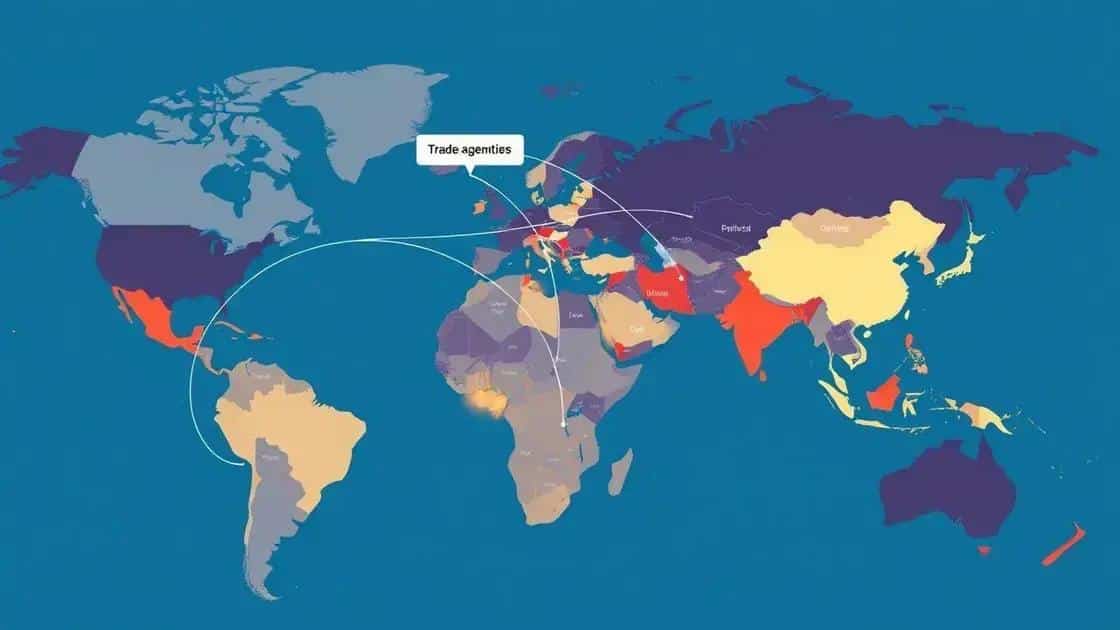Lead us trade agreement: understanding its implications

The lead us trade agreement enhances economic cooperation by reducing trade barriers, promoting growth, and improving competitiveness among participating countries while also facing challenges like regulatory differences and political resistance.
Lead us trade agreement is reshaping how nations engage in commerce. Have you ever wondered what that means for businesses like yours? Let’s dive into the details and explore its implications.
What is the lead us trade agreement?
The lead us trade agreement is a crucial framework that outlines the rules and guidelines for trade between the participating countries. This agreement aims to enhance economic cooperation and to facilitate trade relations. It serves as a vital instrument to promote growth and create opportunities for businesses.
Definition and Purpose
Essentially, the lead us trade agreement is designed to reduce tariffs, eliminate trade barriers, and foster a more open trading environment. By setting clear regulations, it helps streamline processes for exporters and importers alike.
Key Features
- Reduction of tariffs on goods
- Increased market access for businesses
- Protection of intellectual property rights
- Commitments to environmental and labor standards
Furthermore, the agreement encourages collaboration among countries. This collaboration can lead to innovation and improve supply chain efficiency. When countries work together, they create a stronger economic landscape that benefits everyone involved.
Overall, understanding the lead us trade agreement helps businesses prepare for the changes it brings. As trade dynamics evolve, companies must adapt to stay competitive in the global market. Knowing what the agreement entails is the first step in leveraging its benefits.
Key benefits for participating countries
Participating in the lead us trade agreement offers several significant benefits for countries involved. These advantages can enhance economic growth and foster international relationships. Countries can experience improved market access, which opens up opportunities for their businesses.
Economic Growth
One of the main benefits is the potential for economic growth. By reducing trade barriers, countries can increase exports, leading to more jobs and higher incomes. This boost in the economy can help improve living standards.
Enhanced Competitiveness
- Increased access to new markets
- Opportunities for innovation and collaboration
- Reduction in the cost of goods and services
- Improved supply chain efficiency
In addition, the agreement promotes enhanced competitiveness among member countries. By fostering an environment where businesses can thrive, countries can encourage innovation and improve the quality of goods and services. This competitiveness not only benefits local businesses but also consumers, who have access to better products.
Another advantage is the strengthening of international relations. Countries that engage in trade agreements often find it easier to work together in other areas, such as politics and security. This creates a more stable and cooperative global environment, benefiting everyone involved.
Overall, the lead us trade agreement provides a framework that supports economic development, enhances competitiveness, and strengthens diplomatic ties among countries.
Impact on local economies and businesses

The lead us trade agreement has a profound impact on local economies and businesses. By creating a more open market, it allows for easier access to goods and services. This change can lead to increased competition and innovation, which are essential for economic growth.
Boosting Local Economies
When countries enter into trade agreements, local economies often flourish. The influx of goods can mean lower prices for consumers. Businesses may also benefit from cheaper raw materials, which can reduce production costs and boost profitability.
Support for Small Businesses
- Access to larger markets
- Opportunity for growth and expansion
- Improved supply chain efficiency
- Increased collaboration and partnerships
Small businesses especially can thrive under the lead us trade agreement. With access to larger markets, they have a greater chance to expand their customer base. This growth can lead to job creation, which is vital for any community. Furthermore, improved supply chain efficiency means that businesses can operate more smoothly and respond faster to market demands.
Local economies can also see an increase in foreign investment as a result of this agreement. When businesses have confidence in trade relations, they are more likely to invest in new projects and infrastructure. This investment not only creates jobs but also strengthens the overall economy.
In addition, as businesses grow and innovate, consumers benefit from better products and services. The presence of competition encourages companies to improve their offerings, leading to a more dynamic market where customers can choose from a wide range of options.
Challenges faced during implementation
While the lead us trade agreement brings numerous benefits, it also presents several challenges during implementation. These challenges can affect the smooth operation and success of the agreement for participating countries.
Regulatory Differences
One significant challenge is the regulatory differences among member countries. Each nation has its own set of rules and regulations governing trade. Aligning these regulations can be complicated and time-consuming, as countries must negotiate and adapt their standards to ensure compatibility.
Political Resistance
- Local businesses fearing competition
- Public opinion against changes
- Potential loss of jobs in certain sectors
- Concerns over national sovereignty
Another major hurdle is political resistance. Some local businesses may fear competition from foreign companies, leading to opposition against the agreement. Public opinion may also play a role, as people might worry about job losses in specific sectors or question the impact on national sovereignty.
In addition, there can be issues related to infrastructure readiness. Countries may need to invest in their infrastructure to effectively handle the increased trade flow. This could involve upgrading transportation systems, ports, and customs processes, all of which require significant time and financial resources.
Logistical challenges also arise, particularly in ensuring that goods are transported efficiently across borders. Delays in customs processing can create bottlenecks, affecting timelines for businesses that rely on quick delivery. Furthermore, integrating technology systems between countries can be complex, especially with varying levels of technological advancement.
Future outlook and potential changes
The future outlook for the lead us trade agreement is promising, yet it comes with the potential for significant changes. As global trade dynamics evolve, the agreement will need to adapt to maintain its relevance and effectiveness.
Adapting to Technological Advances
One area of focus will be embracing technological advances. Innovations in technology can streamline trade processes, making it faster and more efficient. For example, the use of data analytics and artificial intelligence can enhance decision-making in logistics, reducing delays and improving supply chain management.
Shifts in Global Trade Patterns
- Emerging markets gaining influence
- Changes in consumer preferences
- Impact of climate change on trade routes
- New trade agreements forming
Furthermore, shifts in global trade patterns may influence how the lead us trade agreement is structured. As emerging markets gain influence, countries may need to adjust their trade policies to accommodate these changes. Additionally, evolving consumer preferences can affect which products are in demand, prompting businesses to adapt their strategies.
The impact of climate change is another factor that could lead to potential changes in trade. As weather patterns shift, transport routes may need to be reassessed. Countries must also consider sustainable practices in their trade agreements to accommodate environmental concerns. This focus on sustainability can drive innovation in green technologies and practices, which are likely to become increasingly important.
Lastly, as new trade agreements form globally, the lead us trade agreement may be revisited to ensure it remains competitive and beneficial for all parties involved. Ongoing negotiations and collaborations will be crucial for adapting to the ever-changing landscape of international trade.
FAQ – Questions about the lead us trade agreement
What are the main benefits of the lead us trade agreement for countries?
The agreement promotes economic growth, increases market access, and enhances competitiveness among businesses.
What challenges do countries face when implementing the agreement?
Countries deal with regulatory differences, political resistance, and the need for infrastructure improvements.
How does technology play a role in the future of the trade agreement?
Embracing technological advancements can streamline processes and enhance efficiency in trade operations.
What impact does the trade agreement have on local businesses?
It opens up larger markets for local businesses, potentially leading to growth, job creation, and improved supply chain efficiency.






